Learn about the different stages young children go through in developing their spelling skills and how phonetic or “invented” spelling can play an important role in helping children learn how to write.
Children advance through identifiable stages in their development as spellers. These stages have been described by several different researchers but all derived from the research of Charles Read and Edmund Henderson in 1971.
Researchers began to understand that learning to spell is not a matter of merely memorizing letter sequences, but of developing and applying linguistic knowledge as well as knowledge of letter-sound relationships and vowel patterns.
Children’s spellings provide a window into their understanding of language, which is informative for understanding their reading as well as their spelling.
High-quality spelling instruction includes building upon a child’s word knowledge and enabling them to move from one stage to the next.
Learn the stages of spelling development below.
Precommunicative stage
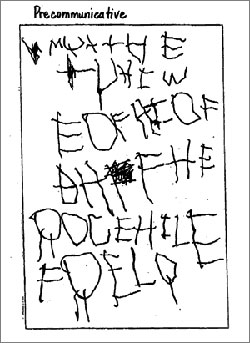
The child uses letters from the alphabet but shows no knowledge of letter-sound correspondences. The child may also lack knowledge of the entire alphabet, the distinction between upper- and lower-case letters, and the left-to-right direction of English orthography (e.g., the letter M used for the word Jessica).
Semiphonetic stage
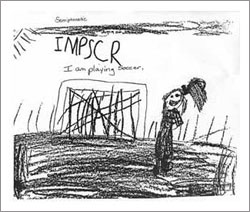
The child begins to understand letter-sound correspondence — that sounds are assigned to letters. At this stage, the child often employs rudimentary logic, using single letters, for example, to represent words, sounds, and syllables (e.g., U for you).
Phonetic stage
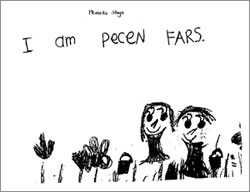
Children use a letter or group of letters to represent every speech sound that they hear in a word. Although some of their choices do not conform to conventional English spelling, their attempts to spell words are systematic and easily understood (e.g., the letters tak for take and en for in).
Transitional stage
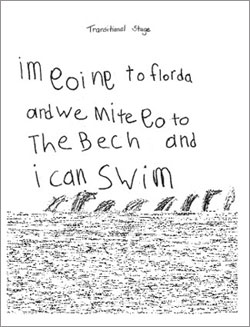
The speller begins to assimilate the conventional alternative for representing sounds, moving from a dependence only or mainly on phonology (sound) for representing words, to evidencing a greater understanding of common letter patterns in words and the structure of words. Some examples of misspelling typical of this stage are egul for eagle and higheked for hiked.
Correct stage
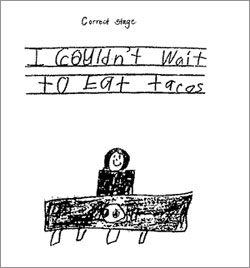
At this stage, spellers know common letter-sound relationships and generalizations (rules) for spelling, as well as how to use morphemic information in spelling. The student understands how to spell many common prefixes and suffixes, silent consonants, alternative spellings, and irregular spellings. A large number of learned words are accumulated, and the speller recognizes incorrect forms. The child’s generalizations about spelling and knowledge of exceptions are usually correct.
The progression through each stage is gradual. In samples of student writing, you will often see examples from more than one stage. Also, the fact that children progress through identifiable stages in their spelling does not mean that spelling development is spontaneous and will simply unfold “naturally,” without instruction. To the contrary, direct instruction in spelling is vital and shapes children’s progression through each of the stages.
“Invented” spelling
Invented spelling refers to a child’s use of phonetic spelling strategies in attempting to write unknown words. For example, a young child might spell the word cake as kak or the word garage as guraj.
The use of invented spelling has some important advantages for beginning spellers. First, it allows young children to express their thoughts in writing without become excessively focused on spelling every single word correctly. Also, there is evidence that when children are encouraged to use invented spelling properly — for example, to say an unknown word orally and “stretch” it, listening for and transcribing each sound — the use of invented spelling may help promote important reading-related abilities such as phonemic awareness and phonics skills.
Does “invented” spelling interfere with standard spelling?
If used properly at the beginning stages of spelling development, phonetic or “invented” spelling can play an important role in helping children learn how to write. When children use phonetic spelling, they are applying their growing knowledge of phonemes and letters, and developing their confidence in the alphabetic principle. A child’s iz for the conventional is can be celebrated as quite a breakthrough! This kind of error shows us that the child is thinking independently and quite analytically about the sounds of words and the logic of spelling.
However, explicit teaching of conventional spelling from the earliest grades is also very important. Without explicit instruction, most children will not simply infer the correct spelling of all the words they need to learn in order to write well. A thoughtful approach should be used, combining an understanding of invented spelling with formal spelling instruction.
Invented spelling
In a Connecticut suburb, first grade teacher Carol Spinello turns a spelling lesson into something of a game.
